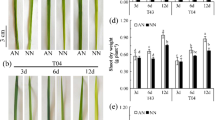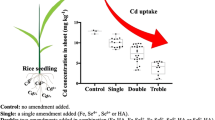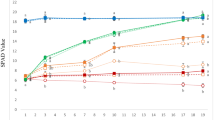Abstract
Comparative studies on the effect of nitrogen (N) form on iron (Fe) uptake and distribution in maize (Zea mays L. cv Yellow 417) were carried out through three related experiments with different pretreatments. Experiment 1: plants were precultured in nutrient solution with 1.0×10−4 M FeEDTA for 6 d and then exposed to NO3–N or NH4–N solution with 1.0×10−4 M FeEDTA or without for 7 d. Experiment 2: plants were precultured with 59FeEDTA for 6 d and were then transferred to the solution with different N forms, and 0 and 1.0×10−4 M FeEDTA for 8 d. Experiment 3: half of roots were supplied with 59FeEDTA for 5 d and then cut off, with further culturing in treatment concentrations for 7 d. In comparison to the NH4-fed plants, young leaves of the NO3-fed plants showed severe chlorosis under Fe deficiency. Nitrate supply caused Fe accumulation in roots, while NH4–N supply resulted in a higher Fe concentration in young leaves and a lower Fe concentration in roots. HCl-extractable (active) Fe was a good indicator reflecting Fe nutrition status in maize plants. Compared with NO3-fed plants, a higher proportion of 59Fe was observed in young leaves of the Fe-deficient plants fed with NH4–N. Ammonium supply greatly improved 59Fe retranslocation from primary leaves and stem to young leaves. Under Fe deficiency, about 25% of Fe in primary leaves of the NH4-fed plants was mobilized and retranslocated to young leaves. Exogenous Fe supply decreased the efficiency of such 59Fe retranslocation. The results suggest that Fe can be remobilized from old to young tissues in maize plants but the remobilization depends on the form of N supply as well as supply of exogenous Fe.
Similar content being viewed by others
References
Alloush G A, Le Bot J, Sanders F E and Kirkby E A 1990 Mineral nutrition of chickpea plants supplied with NO3-N or NH4-N. I. Ionic balance in relation to iron stress. J. Plant Nutr. 13, 1575–1590.
Arnon D J 1949 Copper enzymes in isolated chloroplasts: Polyphenoloxidase in Beta vulgaris. Plant Physiol. 24, 1–15.
Arnozis P A and Findenegg G R 1988 Electrical charge balance in the xylem sap of beet and sorghum plants grown with either NO3? or NH4+ nitrogen. J. Plant Physiol. 125, 441–449.
Bukovac M J and Wittwer A H 1957 Absorption and mobility of foliar applied nutrients. Plant Physiol. 32, 428–435.
Kosegarten H U, Hoffmann B and Mengel K 1999 Apoplastic pH and Fe3+ reduction in intact sunflower leaves. Plant Physiol. 121, 1069–1079.
Kosegarten H, Schwed U, Wilson G and Mengel K 1998 Comparative investigation on the susceptibility of faba bean (Vicia faba L.) and sunflower (Helianthus annuus L.) to iron chlorosis. J. Plant Nutr. 21, 1511–1528.
Marschner H 1995 Mineral Nutrition of Higher Plants. 2nd Edition. Academic Press, London. 889 p.
Mengel K 1995 Iron availability in plant tissues: iron chlorosis on calcareous soils. In Iron Nutrition in Soils and Plants. Ed. J Abadia. pp 389–396. Kluwer Academic Publishers, Dordrecht.
Mengel K and Geurtzen G 1988 Relationship between iron chlorosis and alkalinity in Zea mays. Physiol. Plant 72, 460–465.
Mengel K, Planker R and Hoffman B 1994 Relationship between leaf apoplast pH and iron chlorosis of sunflower (Helianthus annuus L.). J. Plant Nutr. 17, 1053–1065.
Pandey D P and Kannan S 1979 Absorption and transport of iron in plants as influenced by the major nutrient elements. J. Plant Nutr. 1, 55–63.
Sattelmacher B, Mühling K H and Pennewi S S K 1998 The apoplast - its significance for the nutrition of higher plants. Z. Pflanzenernähr. Bodenkd 161, 485–497.
Strasser O, Koehl K and Römheld V 1999 Overestimation of apoplastic Fe in roots of soil grown plants. Plant Soil 210, 179–187.
Takkar P N and Kaur N P 1984 HCl method for Fe2+ estimation to resolve iron chlorosis in plants. J. Plant Nutr. 7, 81–90.
van Beusichem M L, Kirkby E A and Baas R 1988 Influence of nitrate and ammonium nutrition on the uptake, assimilation, and distribution of nutrients in Ricinus Communis. Plant Physiol. 86, 914–921.
Zhang F, Römheld V and Marschner H 1991 Role of the root apoplasm for iron acquisition by wheat plants. Plant Physiol. 97, 1302–1305.
Zhang C, Römheld V and Marschner H 1995 Retranslocation of iron from primary leaves of bean plants under iron deficiency. J. Plant Physiol. 146, 268–272.
Zhang C, Römheld V and Marschner H 1996 Effect of primary leaves on 59Fe uptake by roots and 59Fe distribution in the shoot of iron sufficient and iron deficient bean (Phaseolus vulgaris L.) plants. Plant Soil 182, 75–81.
Author information
Authors and Affiliations
Rights and permissions
About this article
Cite this article
Zou, C., Shen, J., Zhang, F. et al. Impact of nitrogen form on iron uptake and distribution in maize seedlings in solution culture. Plant and Soil 235, 143–149 (2001). https://doi.org/10.1023/A:1011902320662
Issue Date:
DOI: https://doi.org/10.1023/A:1011902320662




